The News
Washington and New Delhi will unveil a string of new arms deals and security arrangements when Indian Prime Minister Narendra Modi visits the U.S. this week, part of the Biden administration’s efforts to counter Beijing’s influence in Asia.
Chief among these is expected to be a major technology-transfer agreement that will allow General Electric to jointly build jet engines with India defense companies for New Delhi’s next generation light combat aircraft. Such a sharing of advanced U.S. defense technology is rare, according to defense industry executives and analysts briefed on the trip, and signals Washington’s desire to transform India into a major strategic partner in Asia.
U.S. National Security Advisor Jake Sullivan visited New Delhi last week to finalize the details concerning Modi’s visit. And he stressed to the Indian media that the “deliverables” from the meeting “are fundamentally designed to remove those obstacles in defense trading, in high tech trade, in investment in each of our countries.”
Modi’s visit comes against a backdrop of tense relations between Washington and Beijing, even as U.S. Secretary of State Antony Blinken made a much-delayed trip to China over the weekend. Both countries have jockeyed for influence and strategic advantage on each other’s doorsteps.
In this article:
Know More
The Biden administration is seeking to put in place concrete systems to permanently reorient New Delhi away from its historic dependence on Russian arms. Other military transactions that could be finalized this week include the U.S. sales of unarmed and armed drones to India that will help the country better police its borders and waters against increasing Chinese incursions.
Reuters reported in New Delhi that Biden and Modi will also discuss jointly producing munitions and armored personnel carriers for the Indian armed forces.
Jay’s view
Senior Biden administration officials have described India as the U.S.‘s most consequential bilateral relationship for the coming century. They cite the country’s geographic positioning to balance China, New Delhi’s status as the world’s largest democracy, and India’s vibrant technology sector. But it’s not clear if Modi — or any other Indian leader — truly wants to embrace this role as Beijing’s foil.
Since taking office, the Biden administration has worked to better integrate India into the U.S.’s defense alliances and partnerships that are designed to counter Beijing and maintain the free flow of commerce and trade through the Indo-Pacific. The White House has held regular strategic discussions with the Quad nations, which include Japan, Australia, and India. And the Pentagon has stepped up war games and military exercises with India, often with Quad members and other Asian countries participating.
The White House is also seeking to broaden the recently unveiled defense alliance, called AUKUS, which initially is focused on building nuclear powered submarines with the U.K. and Australia. But U.S. officials have told Semafor they’re seeking to expand this partnership into a second pillar that will include the development of hypersonic weapons, quantum computing, and underwater vehicles. India is one of the countries likely to cooperate with AUKUS on these military technologies, either directly or informally.
“The fact is I don’t know of a bilateral relationship that has deepened and strengthened more rapidly than the United States and India over the past 20 years,” Biden’s chief Asia strategist, Kurt Campbell, said recently.
Room for Disagreement
There is growing skepticism among a number of former U.S. officials that India will truly emerge as a critical American defense and political partner in the coming decades. For one, they accuse Modi of seriously chipping away at New Delhi’s democratic and judicial institutions, and marginalizing and suppressing India’s 200 million Muslim minority. Modi’s ruling BJP party recently stripped leading opposition figure Rahul Gandhi of his parliamentary status for allegedly defaming the prime minister in a 2019 speech.
There are also questions about whether India would truly support the U.S. and its formal Asian allies — such as Japan, South Korea, Australia, and the Philippines — if they ever engage in direct conflict with China. These former officials believe New Delhi is happy to accept greater U.S. military and technology cooperation to deal with India’s border and maritime disputes with Beijing. But the cooperation might end there.
“The United States should certainly help India to the degree compatible with American interests. But it should harbor no illusions that its support, no matter how generous, will entice India to join it in any military coalition against China,” Ashley Tellis, a former State Department adviser and Carnegie Endowment senior fellow, wrote in Foreign Affairs last month. “The relationship with India is fundamentally unlike those that the United States enjoys with its allies.”
Notable
- Human rights groups are calling on President Biden to directly raise India’s alleged backsliding on democracy with Modi during the state visit. And they’ve criticized Washington’s silence on the issue to date. “Even when confronted with questions by Indian reporters about human rights in India, your administration has only had private two-way conversations about how both of our governments can always improve,” Hindus for Human Rights wrote in an open letter this month “Quite frankly, we find it unacceptable to see such equivocation on Indian democracy.”
- Micron Technology is close to agreeing to invest $1 billion in a semiconductor packaging facility in India, backing a U.S. effort to “friendshore” global technology supply lines.
- Freedom House concluded in a recent report that India is now only “partly free.”
